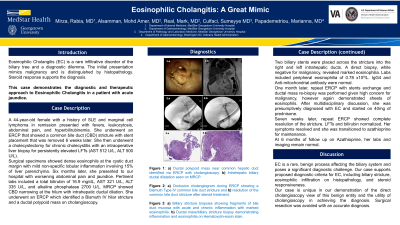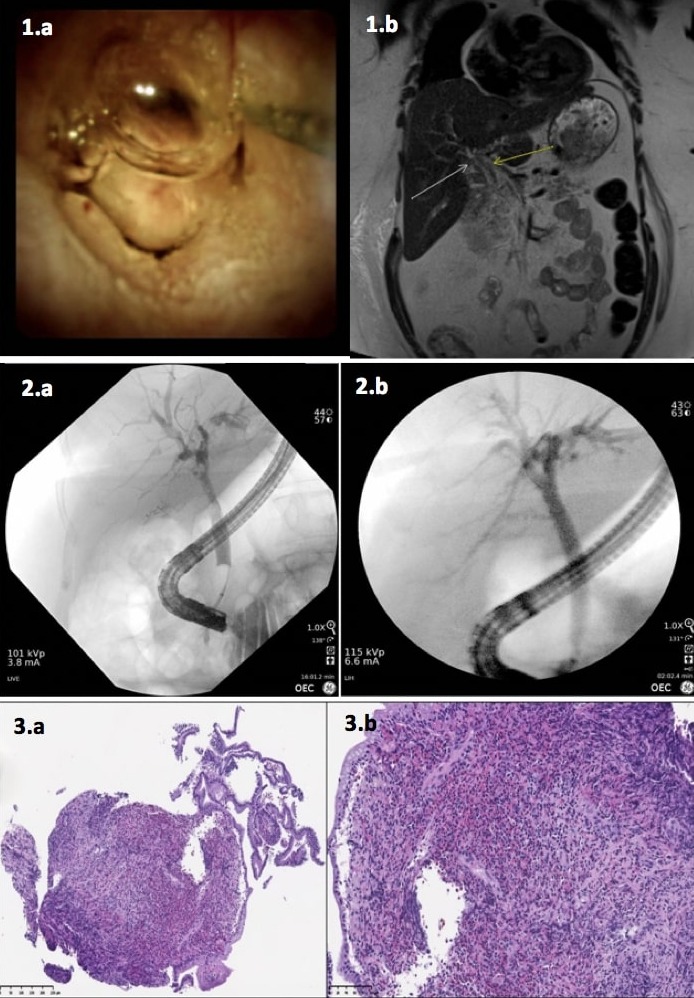Back


Poster Session E - Tuesday Afternoon
Category: Biliary/Pancreas
E0047 - Eosinophilic Cholangitis: A Great Mimic
Tuesday, October 25, 2022
3:00 PM – 5:00 PM ET
Location: Crown Ballroom

Has Audio
- RM
Rabia Mirza, MD
MedStar Georgetown University Hospital
Washington, District of Columbia
Presenting Author(s)
Rabia Mirza, MD1, Mohd Amer Alsamman, MD1, Mark Real, MD2, Sumeyye Culfaci, MD1, Marianna Papademetriou, MD3
1MedStar Georgetown University Hospital, Washington, DC; 2Medstar Georgetown University Hospital, Washington, DC; 3Washington DC Veterans Health Administration, Washington, DC
Introduction: Eosinophilic Cholangitis (EC) is a rare infiltrative disorder of the biliary tree and a diagnostic dilemma. The initial presentation mimics malignancy and is distinguished by histopathology. Steroid response supports the diagnosis. This case elucidates the diagnostic and therapeutic approach to EC in a patient with acute jaundice.
Case Description/Methods: A 44-year-old female with a history of SLE and marginal cell lymphoma in remission presented with fevers, leukocytosis, abdominal pain, and hyperbilirubinemia. She underwent an ERCP that showed a common bile duct (CBD) stricture with stent placement that was removed 6 weeks later. She then underwent a cholecystectomy for chronic cholecystitis with an intraoperative liver biopsy for persistently elevated LFTs (AST 512 U/L, ALT 500 U/L). Surgical specimens showed dense eosinophils at the cystic duct margin with mild non-specific lobular inflammation involving 15% of liver parenchyma. Six months later, she presented to our hospital with worsening abdominal pain and jaundice. Pertinent labs included a total bilirubin of 16.9 mg/dL, AST 321 U/L, ALT 335 U/L, and alkaline phosphatase 2700 U/L. MRCP showed CBD narrowing at the hilum with intrahepatic ductal dilation She underwent an ERCP which identified a Bismuth IV hilar stricture and a ductal polypoid mass on cholangioscopy. Two biliary stents were placed across the stricture into the right and left intrahepatic ducts. A direct biopsy, while negative for malignancy, revealed marked eosinophilia. Labs included peripheral eosinophilia of 0.78 x109/L. IgG4 and Anti-mitochondrial antibody were normal. A month later, repeat ERCP with stents exchange and ductal mass re-biopsy was performed given high concern for malignancy, however again demonstrated sheets of eosinophils. After multidisciplinary discussion, she was presumptively diagnosed with EC and started on 40mg of prednisone. Seven weeks later, repeat ERCP showed complete resolution of the stricture. LFTs and bilirubin normalized. Her symptoms resolved and she was transitioned to azathioprine for maintenance.
Discussion: EC is a rare, benign process affecting the biliary system and poses a significant diagnostic challenge. Our case supports proposed diagnostic criteria for EC, including biliary stricture, eosinophilic infiltration on histopathology, and steroid responsiveness. Our case is unique in our demonstration of the direct cholangioscopy view of this benign entity and the utility of cholangioscopy in achieving the diagnosis.

Disclosures:
Rabia Mirza, MD1, Mohd Amer Alsamman, MD1, Mark Real, MD2, Sumeyye Culfaci, MD1, Marianna Papademetriou, MD3. E0047 - Eosinophilic Cholangitis: A Great Mimic, ACG 2022 Annual Scientific Meeting Abstracts. Charlotte, NC: American College of Gastroenterology.
1MedStar Georgetown University Hospital, Washington, DC; 2Medstar Georgetown University Hospital, Washington, DC; 3Washington DC Veterans Health Administration, Washington, DC
Introduction: Eosinophilic Cholangitis (EC) is a rare infiltrative disorder of the biliary tree and a diagnostic dilemma. The initial presentation mimics malignancy and is distinguished by histopathology. Steroid response supports the diagnosis. This case elucidates the diagnostic and therapeutic approach to EC in a patient with acute jaundice.
Case Description/Methods: A 44-year-old female with a history of SLE and marginal cell lymphoma in remission presented with fevers, leukocytosis, abdominal pain, and hyperbilirubinemia. She underwent an ERCP that showed a common bile duct (CBD) stricture with stent placement that was removed 6 weeks later. She then underwent a cholecystectomy for chronic cholecystitis with an intraoperative liver biopsy for persistently elevated LFTs (AST 512 U/L, ALT 500 U/L). Surgical specimens showed dense eosinophils at the cystic duct margin with mild non-specific lobular inflammation involving 15% of liver parenchyma. Six months later, she presented to our hospital with worsening abdominal pain and jaundice. Pertinent labs included a total bilirubin of 16.9 mg/dL, AST 321 U/L, ALT 335 U/L, and alkaline phosphatase 2700 U/L. MRCP showed CBD narrowing at the hilum with intrahepatic ductal dilation She underwent an ERCP which identified a Bismuth IV hilar stricture and a ductal polypoid mass on cholangioscopy. Two biliary stents were placed across the stricture into the right and left intrahepatic ducts. A direct biopsy, while negative for malignancy, revealed marked eosinophilia. Labs included peripheral eosinophilia of 0.78 x109/L. IgG4 and Anti-mitochondrial antibody were normal. A month later, repeat ERCP with stents exchange and ductal mass re-biopsy was performed given high concern for malignancy, however again demonstrated sheets of eosinophils. After multidisciplinary discussion, she was presumptively diagnosed with EC and started on 40mg of prednisone. Seven weeks later, repeat ERCP showed complete resolution of the stricture. LFTs and bilirubin normalized. Her symptoms resolved and she was transitioned to azathioprine for maintenance.
Discussion: EC is a rare, benign process affecting the biliary system and poses a significant diagnostic challenge. Our case supports proposed diagnostic criteria for EC, including biliary stricture, eosinophilic infiltration on histopathology, and steroid responsiveness. Our case is unique in our demonstration of the direct cholangioscopy view of this benign entity and the utility of cholangioscopy in achieving the diagnosis.

Figure: Figure 1: a) Ductal polypoid mass near common hepatic duct identified via endoscopic retrograde cholangiopancreatography with cholangioscopy. b) Intrahepatic biliary ductal dilatation seen on magnetic resonance cholangiopancreatography.
Figure 2: a) Occlusion cholangiogram during endoscopic retrograde cholangiopancreatography showing a Bismuth Type IV common bile duct stricture. b) Occlusion cholangiogram during endoscopic retrograde cholangiopancreatography showing resolution of the common bile duct stricture after steroid treatment.
Figure 3: a) Biliary stricture biopsies showing fragments of bile duct mucosa with acute and chronic inflammation with marked eosinophilia. b) Ductal mass/biliary stricture biopsy demonstrating inflammation and eosinophilia on Hematoxylin-eosin stain.
Figure 2: a) Occlusion cholangiogram during endoscopic retrograde cholangiopancreatography showing a Bismuth Type IV common bile duct stricture. b) Occlusion cholangiogram during endoscopic retrograde cholangiopancreatography showing resolution of the common bile duct stricture after steroid treatment.
Figure 3: a) Biliary stricture biopsies showing fragments of bile duct mucosa with acute and chronic inflammation with marked eosinophilia. b) Ductal mass/biliary stricture biopsy demonstrating inflammation and eosinophilia on Hematoxylin-eosin stain.
Disclosures:
Rabia Mirza indicated no relevant financial relationships.
Mohd Amer Alsamman indicated no relevant financial relationships.
Mark Real indicated no relevant financial relationships.
Sumeyye Culfaci indicated no relevant financial relationships.
Marianna Papademetriou indicated no relevant financial relationships.
Rabia Mirza, MD1, Mohd Amer Alsamman, MD1, Mark Real, MD2, Sumeyye Culfaci, MD1, Marianna Papademetriou, MD3. E0047 - Eosinophilic Cholangitis: A Great Mimic, ACG 2022 Annual Scientific Meeting Abstracts. Charlotte, NC: American College of Gastroenterology.
